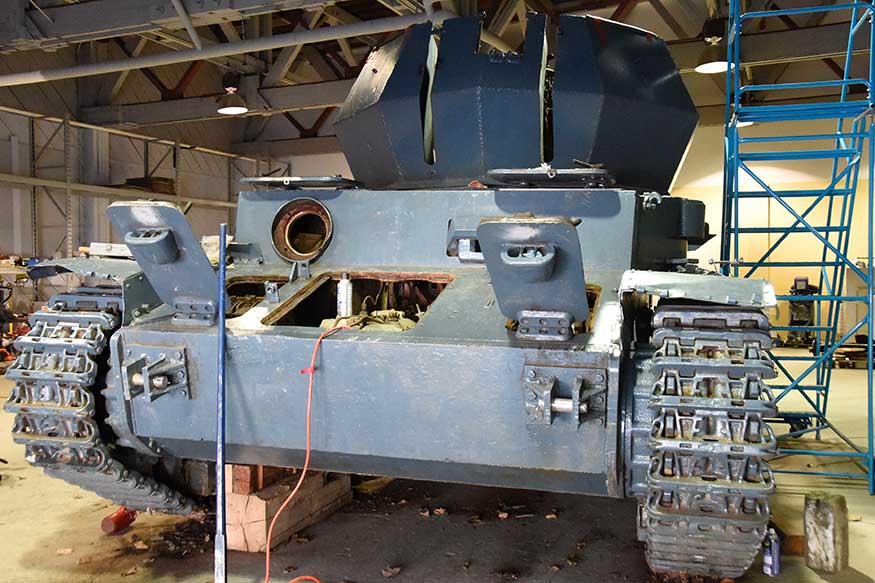By / Par Brooke Belliveau, Citoyen Borden Citizen
It may not look like the most welcoming place to crawl into, but a group of dedicated volunteers is more than happy to wiggle into the rusty belly of a 70-year-old, German Flakpanzer tank.
The word Flak is the acronym of the German military term: Fliegerabwherkanone that literally translates as “Canon against planes’”. What we call in good spoken English, “anti-aircraft gun’’. The well-known common English expression ‘to take some Flak’ meaning taking a hard time, or reprimanding from someone, derives from World War 2 Bomber crew lingo. They used this saying to describe the hard times flying bombing mission runs through the German anti-aircraft gun barrages.
The tank, one of only two of its kind globally, was lifted from its place at Worthington Park on a drizzly October morning, and transported to building E-146 to undergo an extensive restoration.
Now, nearly five months later, the work is well underway. The eleven volunteers are split into two crews: the Chassis Crew and the Turret Crew. Each group has a very specific, immediate objective.
“Because we have to remove the turret and the gun mount, there is a big push to free up the road wheels and the braking system. Here are your steering and your transmission, so what the guys are doing is working to ensure the transmission is in neutral and the brakes are no longer seized up in rust so that they can make this roll,” explains Steve Facciol, as he points to the front of the tank. The Chassis Crew is completing this work. “Once they can make this roll, we will pull it [outside] and the [Turret Crew will] lift the gun mount off, and then put it back in after the gun is fully restored.” Facciol is responsible for communications, promotions and fundraising for the restoration project. The many rafters running across the ceiling of the building that houses the tank don’t allow for this gun and turret lifting work to be completed inside, posing a bit of a challenge.
The group has gained excellent publicity through their Facebook page, with international followers and interest that proves to be very helpful and encouraging.
“Well known military author from Ireland, Hilary Doyle, who wrote a book on these Flakpanzers posted on the Facebook page and he replied after seeing a photo of the serial number, “Okay, so your tank [chassis # 90124] was built late April 1944, in the Nibelungen-Werke [Nibelung factory] in St. Vincent, Austria.” Just by seeing the chassis number this guy knew,” explained Captain Despatie, who is a key organizer of the project. Encouraging comments in various languages can be seen on many other posts as well.
Media outlets have come to cover the project, allowing locals a more in-depth view of the amazing work that is being done close to home. The crew hopes to bring attention to not just their initiative, but also the wider wealth of military history that is available to the community at CFB Borden. “The big part of this project is getting the community involved, because we are going to need all of the help that we can get. Even just the guys at the museum getting the exposure is excellent,” explains Facciol.
Work is being completed every other Saturday, as the project is purely a volunteer effort. Those who are interested in following this amazing restoration project can monitor progress and contact the team through their Facebook page, Flakpanzer Restoration Project or email at: BordenMuseumVolunteers@gmail.com. The next work session 18 March 1330 – 1630 hrs, E-146 (beside the Museum). Starting April, the crew will move to 1st and 3rd Saturday of the month.
Suivi relatif au Flakpanzer
Même si cette tâche déplairait à la majorité des gens, un groupe de bénévoles dévoués se fait un plaisir de se faufiler dans les entrailles rouillées d’un char allemand Flakpanzer de 70 ans.
Le terme « Flak » est l’acronyme du terme militaire allemand « Fliegerabwherkanone », qui se traduit littéralement par « canon anti-avions ». C’est ce qu’on appelle communément un canon antiaérien. Les membres d’équipage de bombardiers de la Deuxième Guerre mondiale ont inventé, à partir de ce terme allemand, la populaire expression « encaisser les coups », qui signifie « se faire réprimander ou taquiner ou se faire mener la vie dure par quelqu’un ». Ils utilisaient cette expression pour décrire la difficulté des missions de bombardement au-dessus de barrages de canons antiaériens allemands.
Le char, qui compte parmi les deux seuls modèles de ce type dans le monde, a été retiré de son emplacement au parc Worthington un matin d’octobre bruineux, puis transporté jusqu’au bâtiment E-146 afin d’y subir d’importants travaux de restauration.
Maintenant, près de cinq mois plus tard, les travaux sont bien avancés. Les onze bénévoles sont divisés en deux équipes : l’équipe du châssis et l’équipe de la tourelle. Chaque groupe a un objectif immédiat très spécifique.
« Puisqu’il faut retirer la tourelle et l’affût du canon, il est essentiel de dégager les galets de roulement et le système de freinage. Voici la direction et voilà la transmission. Il faut s’assurer que la transmission est au neutre et que les freins ne sont plus bloqués par la rouille afin de pouvoir faire rouler le char », explique Steve Facciol, en pointant vers l’avant du char. L’équipe du châssis effectue ces travaux. « Une fois que le char pourra rouler, on le fera avancer [jusqu’à l’extérieur] et [l’équipe de la tourelle] retirera l’affût du canon, et le remettra en place une fois que le canon aura été entièrement restauré. » Steve Facciol est responsable des communications, de la promotion et de la collecte de fonds pour le projet de restauration. Les nombreux chevrons sur le plafond du bâtiment où se trouve le char empêchent tout levage du canon et de la tourelle à l’intérieur, ce qui complique les travaux.
Le groupe a bénéficié d’une excellente publicité grâce à sa page Facebook, qui a attiré des abonnés internationaux et a suscité un intérêt qui s’est avéré très utile et encourageant.
« Hilary Doyle, auteur militaire irlandais bien connu qui a écrit un livre sur les chars Flakpanzer, a publié sur la page Facebook et a répondu ce qui suit après avoir vu une photo du numéro de série : « Votre char [châssis n# 90124] a été construit à la fin du mois d’avril 1944, à l’usine Nibelungenwerke à St. Vincent, en Autriche. ». Il a su juste en voyant le numéro de châssis », a expliqué le capitaine Despatie, qui est un organisateur clé du projet. De plus, des commentaires d’encouragement dans diverses langues figurent parmi les commentaires de plusieurs autres publications.
Les médias ont couvert le projet, ce qui a donné à la population locale un aperçu plus détaillé de l’excellent travail qui est effectué dans la région. L’équipe espère attirer l’attention sur leur initiative, mais également sur une plus grande part de l’histoire militaire qui est disponible pour la communauté à la BFC Borden. « Le projet vise en grande partie à faire participer la communauté, car nous aurons besoin de toute l’aide possible. Le simple fait de donner de la visibilité aux employés du musée est excellent », explique Steve Facciol.
Des travaux sont effectués un samedi sur deux, car le projet est un effort entièrement bénévole. Ceux qui souhaitent suivre l’avancement de cet incroyable projet de restauration peuvent surveiller les progrès et communiquer avec l’équipe sur la page Facebook « Flakpanzer Restoration Project », ou à l’adresse suivante : BordenMuseumVolunteers@gmail.com. La prochaine séance de travail aura lieu le 18 mars de 13 h 30 à 16 h 30, au bâtiment E-146 (à côté du musée). À compter du mois d’avril, l’équipe travaillera sur le projet le premier samedi et le troisième samedi du mois.






